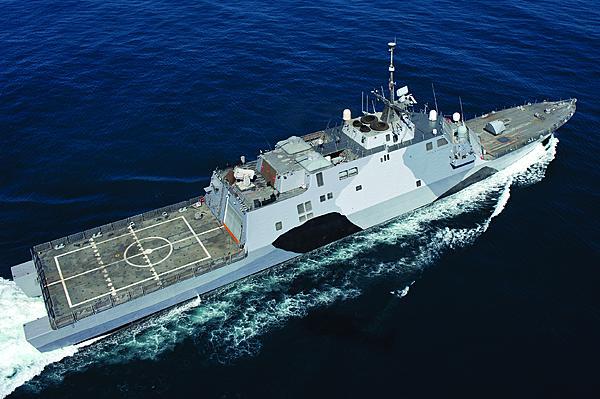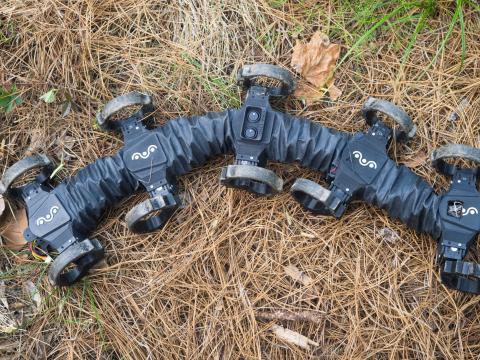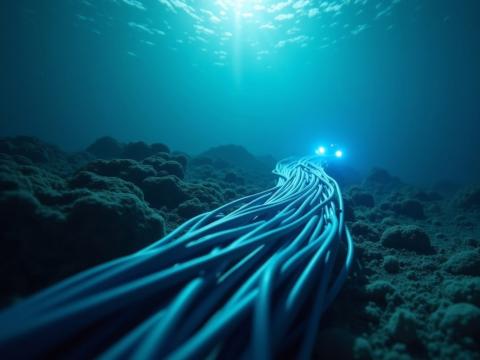Littoral Combat Ship Loaded With Unmanned Systems
The U.S. Navy intends to deploy an arsenal of airborne, surface and underwater unmanned systems for its new shallow-water combat ship. The array of unmanned systems will extend the ship’s intelligence, surveillance and reconnaissance capabilities, enhancing awareness of enemy activities, and will reduce the number of sailors deployed to minefields, saving lives.
The littoral combat ship (LCS) is designed to be a fast, agile and quiet platform for operation primarily near the shore but capable of deep water operation as well. It allows the Navy to swiftly swap mission packages for mine countermeasures, anti-submarine and surface warfare missions. The ship also takes advantage of a modular design, which provides for easy integration of future technologies. “One of the most fabulous things about the littoral combat ship is its modularity. Right now, you have anti-submarine warfare, you have mine countermeasures and then you have surface warfare mission packages. Because of the modularity, anything is possible for the future,” says Capt. Duane Ashton, USN, outgoing program manager for unmanned maritime systems within the LCS program executive office.
All three mission packages will be supported by the MQ-8 Fire Scout vertical take-off and landing unmanned aerial vehicle. It has the ability to autonomously take off and land on any aviation-capable warship. It offers an array of surveillance and reconnaissance capabilities for enhanced situational awareness as well as target acquisition.
In the short term, the Navy is focused on the mine countermeasures mission package, which will use the Knifefish unmanned undersea vehicle, the Unmanned Influence Sweep System and the Remote Minehunting System.
Knifefish will be included in increment four of the mine countermeasure mission package. It is expected to reach initial operating capability in 2017. The system will use low frequency broadband synthetic aperture sonar technology to enable hunting mines in high-traffic environments and will provide improved detection, identification and classification of mines. “It’s a heavyweight unmanned underwater vehicle—21 inches in diameter, essentially 22-feet long and about 2,000 pounds. It’s going to bring capability against buried and proud mines that we don’t currently have capability against,” Capt. Ashton says. Proud mines are mines that rest on the ocean floor.
He adds that Knifefish provides an “intelligence preparation of the operational environment” capability, which will allow measurement of environmental factors, such as water salinity and clarity. “We went through the critical design review in January, so we’re in the process of starting to build our engineering, development and manufacturing model. That is a key step in 2014, to actually start that process and get through acceptance of the vehicle and get into contractor testing to prove out its performance capability,” he asserts. The Navy intends to purchase 30 systems. One system includes two Knifefish vehicles along with launch and recovery equipment and other accessories.
The Unmanned Influence Sweep System is an unmanned surface vehicle designed to eliminate magnetic and acoustic mines. “If there’s a threat out there, we want to fool the mine into thinking the unmanned vehicle is an actual ship and causing it to blow up. It works well. There’s this old adage that says hunt when you can, sweep when you must. It’s very dependent on the environment and on how the mine warfare commander wants to move forward,” Capt. Ashton explains.
The Navy currently relies on the NH-53 helicopter and the MCM-1 class minesweeper ship for much of its mine countermeasure efforts. “As we look at the sundowning of the NH-53 helicopter and the Avenger MCM-1 class, the sweep capability that we’re mainly going to have in the future is going to be with unmanned systems,” Capt. Ashton states.
Navy officials may add mine hunting and neutralization capabilities to the system as well, Capt. Ashton reports. “If you look at how we view mine countermeasures, it’s a serial process. You have to detect and classify and then neutralize the mine threat. We’re working to get all of that capability on one unmanned surface vehicle in the future,” he says. “That’s the vision, and we’re actually starting to march down that path.”
The remote minehunting system, which is being developed through a different program office within the LCS program executive office, uses a remote multimission vehicle to tow an AN/AQS-20A sonar system for detection, classification and localization of mines and for the identification of mines on the ocean floor. A Navy fact sheet describes the system as an autonomous semi-submersible, high-endurance, low-visibility system capable of both line-of-sight and over-the-horizon operations. The off-board vehicle will have self-contained control, propulsion, power and navigation features. Two vehicles may be operated from the LCS simultaneously.
It also will be capable of real-time communications of mine reconnaissance sensor data as well as automatic search and recording. The host ship will communicate tactical mine reconnaissance data to other naval forces.
A streamlined snorkel, or mast, is the vehicle’s only visible feature above the water. The snorkel draws air into the engine and provides a platform for radio frequency antennas and an obstacle avoidance system. The vehicle can find mines in deep and shallow water with high probability and can be programmed to perform autonomously or can be controlled manually via data link. It will be capable of operating more than 24 hours at a time. “That’s going to be the minehunting workhorse for increment one of the mine countermeasures mission package,” Capt. Ashton declares.
The surface warfare mission package provides fleet protection from small boats and other asymmetric threats. It also can provide operational security for interdiction missions against terrorist suspects and pirates, as well as defense against shore attacks. The anti-submarine warfare mission package provides joint force commanders with the capability to detect, engage and defeat modern diesel-electric and nuclear submarines. It is designed to enable operational commanders assured access in contested, anti-access and area denial littoral environments. Specific capabilities include protecting forces in transit; protecting joint operating areas; and establishing anti-submarine warfare barriers.
Furthermore, the anti-submarine mission package will include a number of sensing technologies and processing techniques. Employing an operationally tailored mix of multiple distributed onboard and off-board organic sensors netted together, the mission package will continuously exploit real-time undersea data; maneuver quickly; and employ deception to help detect, classify, identify, target and destroy enemy submarines. It will rely on the MH-60R helicopter equipped with a dipping airborne low-frequency sonar. The helicopter also can deploy standard active and passive sonobuoys, as well as use inverse synthetic aperture radar and forward-looking infrared radar to localize a threat and enable a launch of the MK-54 lightweight hybrid torpedo.
Additionally, the Navy is developing other unmanned systems that have not yet been assigned to specific mission packages. For example, the Large Displacement Unmanned Underwater Vehicle is designed to operate in deep and shallow waters, including harbor areas. It also will provide intelligence preparation of the operational environment. “We’re looking at the possibility of both submarines and ships like the littoral combat ship as potential platforms for this capability. The mission package is something to determine as we develop the concept of operations and the concept of employment. I could see it going in either the anti-submarine warfare package or even the surface warfare package,” Capt. Ashton indicates.
The Navy recently completed an analysis of alternatives and is currently working out the concepts of operation and employment, Capt. Ashton reports. “Right now, we’re analyzing whether this is something we can do with a large-diameter unmanned underwater vehicle. Ideally, we’ll be able in early fiscal year 2015 to put out a draft request for proposals. We expect a contract award in fiscal year 2016.”
The service also is developing a system known as the Persistent Littoral Undersea Surveillance system, which is designed to detect underwater threats such as diesel submarines. The prototype system consists of an undersea network of five Seaglider autonomous vehicles and six Remus 600 unmanned underwater systems. The Remus 600 is a large, autonomous vessel with long underwater dwell times. It acts as a deep-sea sensor. The Seagliders dive underwater to collect data from Remus, and then return to the surface to transmit that data to a shore-based collection and processing station. Capt. Ashton says an urgent operational need drove the service to develop the Persistent Littoral Undersea Surveillance system.
The captain emphasizes that LCS modularity allows the service to integrate such a wide array of systems while remaining flexible enough to easily insert future technologies as well. “We have a core intelligence, surveillance and reconnaissance capability with the LCS platform, and by adding unmanned systems we expand that reach much farther than the platform itself,” he concludes.





Comments